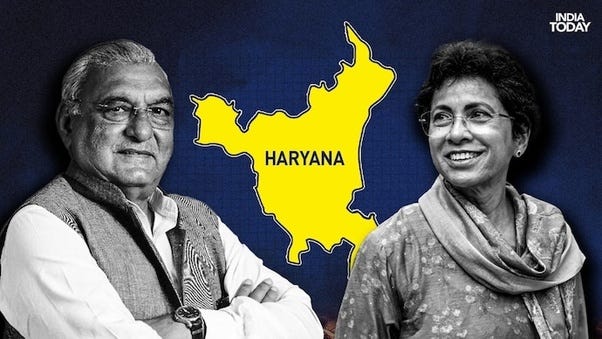
Congress, with its deep-rooted connections to the Jat community, managed to leverage this support to secure a significant portion of the Jat vote, contributing to its strong performance in Jat-majority areas. According to post-election data, the party achieved one of its highest strike rates among Jat voters, securing wins in several constituencies that are heavily influenced by this agrarian community. This success has positioned Congress as a major player in the state, challenging the BJP's dominance in other voter segments.
The BJP, meanwhile, capitalized on its influence among Punjabi and Ahir voters, particularly in urban centers and regions where these communities form a significant part of the population. The party’s appeal to Punjabi voters, who often dominate the business and trading classes in Haryana, allowed it to secure vital seats in key constituencies. Similarly, the Ahir community, concentrated in the southern parts of Haryana, has remained a loyal base for the BJP, further reinforcing its position in those regions.
Analysts believe that the demographic makeup of Haryana has played a crucial role in shaping these voting patterns. Haryana's population is primarily divided among Jats, Punjabis, and Ahirs, with each community historically aligning with different political parties. While Jats have often leaned towards Congress, Punjabis and Ahirs have tended to favor the BJP, creating a distinct electoral landscape in the state.
The Jat community, which constitutes a sizable percentage of Haryana's population, has traditionally played a decisive role in state politics. As a landowning and agriculturally dominant group, Jats wield significant influence in rural areas, particularly in the northern and central parts of the state. Congress's ability to tap into this base, through a combination of candidate selection and targeted campaign messaging, has been instrumental in its electoral success. In constituencies such as Rohtak, Hisar, and Bhiwani, Congress candidates managed to secure victories by consolidating the Jat vote, often outpacing their BJP rivals.
Conversely, the BJP's strategy of focusing on urban centers and regions with a strong Punjabi and Ahir presence paid off in constituencies such as Gurgaon, Faridabad, and Mahendragarh. The party’s pro-business policies and emphasis on development resonated with Punjabi voters, who have historically been more inclined to support parties that champion economic growth. Additionally, the BJP's outreach to the Ahir community, which forms a significant portion of the population in southern Haryana, helped the party retain its grip in key constituencies in that region.
Despite Congress's success among Jats, it faces significant challenges in expanding its appeal beyond this voter base. The BJP’s stronghold among Punjabis and Ahirs has allowed the party to maintain a competitive edge in many constituencies, limiting Congress's ability to dominate the political landscape in Haryana. Moreover, the BJP's organizational strength and ability to mobilize its supporters across different voter segments have enabled the party to retain a firm foothold in the state, despite Congress's gains among Jat voters.
Political observers note that both parties have adopted distinct strategies to cater to their respective voter bases. Congress, with its focus on rural development and agricultural policies, has positioned itself as the party of the Jats, while the BJP has emphasized its pro-business agenda and development initiatives to attract Punjabi and Ahir voters. This divergence in approach has created a political dynamic in Haryana that is deeply influenced by the state's demographic composition.
In terms of policy, Congress has sought to address the concerns of Jat farmers, who have been at the forefront of agricultural protests in the state. The party's emphasis on supporting the agricultural sector, coupled with promises of better irrigation and farm loan waivers, has resonated with Jat voters, many of whom are disillusioned with the BJP's handling of farmer-related issues. This dissatisfaction among Jats has contributed to Congress's resurgence in the state, as the party capitalized on anti-incumbency sentiment and positioned itself as the champion of agrarian interests.
On the other hand, the BJP has focused on infrastructure development, urbanization, and job creation as part of its appeal to Punjabi and Ahir voters. The party's efforts to attract investment and promote industrial growth in Haryana's urban centers have been well-received by these communities, who see economic development as key to their prosperity. The BJP's success in securing seats in urban constituencies underscores its ability to mobilize voters around its development agenda, even as Congress strengthens its position among Jats.
